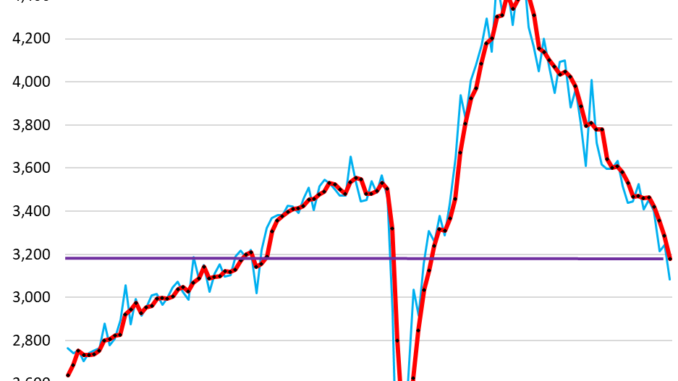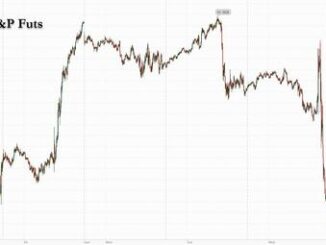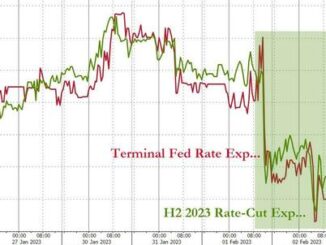
Fewer workers quit (rattled by layoff headlines?), so fewer vacant slots to fill and less hiring. But actual layoffs are at historic lows.
By Wolf Richter for WOLF STREET.
Powell talks a lot about the balance in the labor market, about job openings, quits, layoffs, and hires – and we got the latest data today. They depict a labor market dynamic where workers hang on to their jobs rather than looking for the greener grass on the other side; they either got scared by all the layoff talk as employers re-exert control they’d lost during the pandemic, or they’re happy where they are, and they’re just not quitting anymore, and the number of quits plunged to the lowest level since early 2018.
And because fewer workers quit, there are fewer empty slots left behind that companies have to fill, so fewer job openings – though they remain historically high – and less hiring.
In other words, the historic churn in the labor force during the pandemic has calmed down, while layoffs and discharges remain at historic lows.
But in addition, and disconcertingly, creation of new jobs has also slowed down dramatically – which came out in the data and revisions last month. So we’ll start at the beginning:
Workers quit quitting. Voluntary quits fell to 3.08 million in August, the lowest since January 2018, according to the Job Openings and Labor Turnover Survey (JOLTS) data released today by the Bureau of Labor Statistics, based on surveys of about 21,000 work sites.
The three-month average fell to 3.18 million, the lowest since March 2018. The huge churn during the pandemic, when workers jumped jobs and industries to improve their lot, thereby driving employers nuts and triggering the biggest pay increases in decades, has settled down.
Fewer voluntary quits mean fewer newly open slots that have to be filled, so fewer job openings, and fewer hires to fill those openings.
For employers, this is a huge accomplishment. They have been able to re-exert control and clean out the deadwood. Pay increases have moderated because employers no longer have to poach each other’s employees by offering better pay. Productivity rises when workers stay longer and learn the ropes, which has been helpful for employers.
So fewer job openings to fill, after workers quit quitting. The number of job openings in August rose to 8.04 million. The three-month average, which irons out the month-to-month squiggles, dipped to 7.89 million, the lowest since March 2021.
This number of job openings is still historically high, and would be a record in the data except for the pandemic, but it’s way down from the pandemic’s churn.
Employment has been growing over the years. So in relationship to nonfarm payrolls, the number of job openings is historically high, and still above the pre-pandemic record of January 2019.
In August, the three-month average of job openings was 5.0% of nonfarm payroll, still above the prepandemic record in January 2019 of 4.8%. At the peak before the Great Recession, it topped out at 3.0%.
But this trend needs to start flattening out pretty soon for the labor market to remain healthy.
The number of job openings per unemployed person – another ratio that Powell cites a lot as one of the indicators of labor market tightness – remains above 1. In August, it ticked up to 1.13, meaning there are still more job openings (7.89 million three-month average) than unemployed people looking for work (7.11 million).
While relatively high, the ratio is lower than it was during the hot labor market in late 2018 through February 2020, which was one of the reasons Powell cited as sign of a labor market that is become less tight, and that the Fed doesn’t want to loosen further – hence the 50 basis-point cut.
Layoffs and discharges fell to 1.061 million in August, and the spike in July was revised back down, so the three-month average dipped to 1.63 million. All of these numbers are historically low – meaning employers are shedding people at a rate that is much lower than during the Good Times before the pandemic.
Companies are hanging on to the workers they’ve got; workers aren’t quitting; so there are fewer slots to fill, and fewer job openings, and less need to hire in order to fill those fewer job openings. This is the picture of a labor market that has settled in after huge turmoil during the pandemic.
Layoffs and discharges in relationship to nonfarm employment – a ratio that accounts for growing employment over the years – shows this trend even more forcefully.
Layoffs and discharges were just a hair over 1% of nonfarm employment over the past several months (1.02% in August).
There have been speculations around here at the shop that employers are clinging to their staff because they got burned by the labor shortages after the pandemic when they couldn’t easily rehire the masses of people that they’d let go in the early months of the pandemic. And we speculated that maybe employers actually learned something about the value of retaining talent – and that would be a good thing for everyone, including employers.
Hires dropped to 5.32 million in August – down from July, but up from June. The three-month average dropped to 5.33 million.
Fewer quits and historically low layoffs and discharges as employers hang on to their workers mean fewer job openings to fill, which means less need to hire.
But an additional and more disconcerting reason is that employers are creating new jobs at a slower rate than during the Good Times before the pandemic. The deterioration over the past three months was one of the factors Fed speakers cited for the 50-basis-point cut.
The ratio of hires to nonfarm payrolls dropped to 3.4%, below where it had been in the 2017-2019 years, which were considered a tight labor market (amid Fed rate hikes and QT).
So the labor market has settled down, and fewer people quit, requiring less hiring; but in addition, employers have slowed creating new jobs. And we can see that here too:
We give you energy news and help invest in energy projects too, click here to learn more






